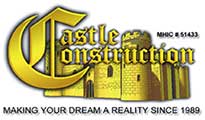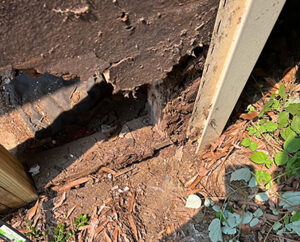At Castle Construction, we understand the importance of maintaining your home’s structural integrity. When it comes to termite damage, prevention is key, but sometimes these pesky insects find their way in. In this comprehensive guide, we’ll walk you through the ins and outs of termite repair, ensuring that your home remains a safe and comfortable haven for you and your family. Termites are a common problem that many homeowners face. These small insects can cause significant damage to the structure of a home, and if left untreated, can lead to costly repairs. Termite repair is the process of fixing the damage caused by termites and preventing future infestations.
Understanding Termites
Termite Species
We, as experts in termite repair, know that there are over 2,700 different species of termites in the world. However, there are only a few species that are commonly found in the United States. These species include:
- Subterranean Termites
- Dry wood Termites
- Damp wood Termites
Subterranean termites are the most common type of termite found in the US. They live in the soil and build tunnels to reach their food source. Dry wood termites, on the other hand, live inside the wood they infest. Damp wood termites are attracted to wood with high moisture content and are commonly found in coastal areas.
Termite Life Cycle
Termites go through several stages of development before they become adults. The life cycle of a termite includes:
- Egg
- Nymph
- Soldier
Reproductive
The egg stage lasts for a few weeks, and then the nymph stage begins. Nymphs molt several times before becoming soldiers or re productive. Soldiers are responsible for defending the colony, while re productive are responsible for mating and starting new colonies.
Signs of Termites
Before we dive into termite repair, it’s crucial to recognize the signs of termite infestation. Detecting these pests early can save you thousands of dollars in repair costs. Look out for the following:
Mud Tubes: Subterranean termites create mud tubes that provide them with moisture. These can often be found along your home’s foundation.
Hollow-Sounding Wood: Tap on wooden surfaces in your home. If they sound hollow, it could be a sign of termite damage.
Discarded Wings: Winged termites, also known as swarmers, shed their wings after a mating flight. Finding discarded wings around your home indicates termite activity.
Tight-Fitting Doors and Windows: Termites can cause wooden structures to warp, making doors and windows difficult to open or close.
The Termite Repair Process
Once you’ve identified termite damage, it’s time to take action. Termite repair involves several key steps to ensure your home is restored to its former glory.
Inspection
Begin by hiring a professional termite inspector to assess the damage thoroughly. They will determine the extent of the infestation and identify the affected areas.
Terminate the Termites
Before any repairs can commence, the termite infestation must be eliminated. Professional extermination methods may include baiting systems or chemical treatments.
Remove Damaged Wood
The next step is removing the compromised wood. This ensures that no hidden termite colonies remain within your walls.
Reinforce Structural Integrity
After the damaged wood has been removed, it’s essential to reinforce the structural integrity of your home. This may involve installing support beams or replacing load-bearing structures.
Repair and Replace
With the structure stabilized, it’s time to repair and replace the damaged areas. This can include patching walls, replacing floorboards, and repainting.
Preventative Measures
To prevent future termite infestations, consider implementing preventative measures such as regular inspections, moisture control, and termite-resistant building materials.
Damage Caused by Termites
Termites are small insects that feed on cellulose, which is found in wood, paper, and other plant-based materials. They are known to cause extensive damage to buildings and furniture. In this section, we will discuss the types of damage caused by termites.
Structural Damage
Termites can cause significant structural damage to buildings. They feed on the wooden structures of buildings, including beams, joists, and rafters. This can weaken the structure of the building and compromise its stability. In severe cases, the building may even collapse.
Termites can also damage other parts of the building, such as the foundation, walls, and roof. They can create tunnels and galleries in these areas, which weakens the structure and can lead to water damage.
Damage to Furniture
In addition to damaging buildings, termites can also cause damage to furniture. They can feed on wooden furniture, including chairs, tables, and cabinets. This can lead to the furniture becoming weakened and eventually falling apart.
Termites can also cause damage to other materials, such as paper and cloth. They can feed on books, photographs, and other paper-based materials, as well as clothing and other fabrics.
DIY vs. Professional Termite Repair
While some minor termite repairs can be tackled as DIY projects, it’s crucial to recognize the limitations of your expertise. For extensive damage or infestations, it’s highly recommended to enlist the services of professionals. They have the knowledge, experience, and equipment needed to effectively address the issue.
Cost of Termite Repair
The cost of termite repair can vary significantly depending on the extent of the damage and the methods employed. It’s advisable to obtain multiple quotes from reputable contractors to ensure you’re getting a fair price.
Insurance Coverage
Check your homeowner’s insurance policy to see if it covers termite damage. While many policies do not, there may be additional coverage options available.
Conclusion
In conclusion, termite damage can pose a significant threat to your home’s structural integrity. Identifying the signs early and taking prompt action is essential in preventing further damage. Whether you choose to tackle minor repairs yourself or enlist professional help, the key is to address the issue swiftly and effectively.
FAQs for Termite Repair
How can I tell if I have termite damage?
Look for signs such as hollow-sounding wood, mud tubes, discarded termite wings, or tiny holes in wood. You may also notice sagging floors or damaged paint.
Can I repair termite damage myself?
Some minor cosmetic repairs can be done by homeowners, but structural damage should be addressed by professionals who can assess the extent of the damage and ensure it is properly repaired.
What are the steps involved in termite repair?
Termite repair typically involves inspection, identifying damaged areas, treating for termites, removing damaged wood, and then repairing or replacing the damaged structural components.
Do I need to treat termites before repairing the damage?
Yes, it’s crucial to eliminate the termite infestation before repairing the damage. Termite treatment is often the first step to prevent further damage.
What materials are used for termite repair?
Materials for termite repair can vary but commonly include treated lumber, wood putty, epoxy, and drywall or plaster for cosmetic repairs.
How much does termite repair cost?
The cost of termite repair varies depending on the extent of the damage and the size of the affected area. It’s advisable to obtain estimates from professional contractors.
Can termite damage be prevented in the future?
Yes, preventive measures include regular termite inspections, maintaining proper ventilation, reducing moisture around your home, and treating wood with termite-resistant chemicals.
Is termite repair covered by homeowners’ insurance?
Typically, homeowners’ insurance does not cover termite damage. It’s essential to have a separate termite protection plan or rider on your policy.
How long does termite repair take?
The duration of termite repair depends on the extent of the damage. Minor repairs may take a few days, while extensive structural repairs could take weeks or even longer.


